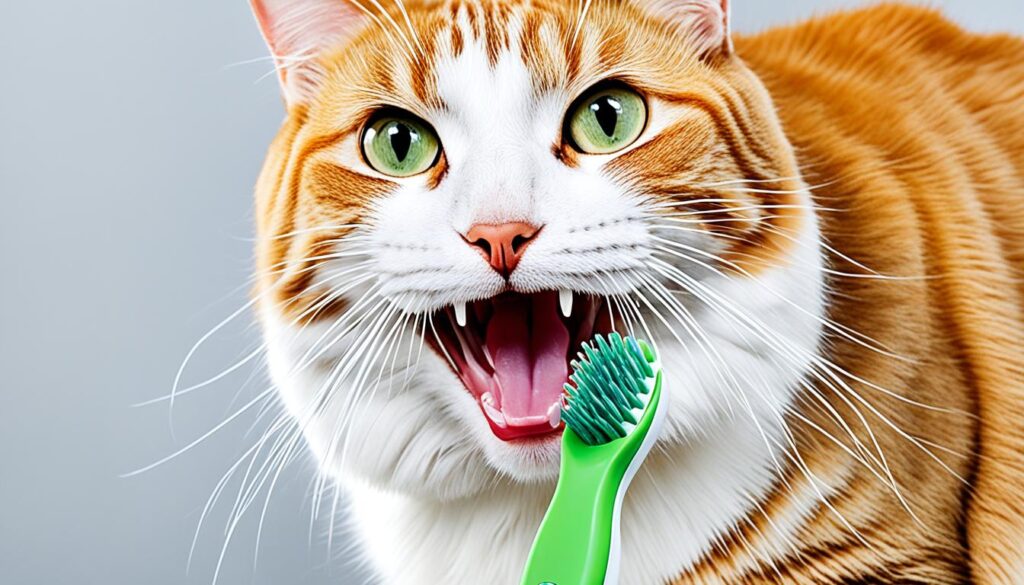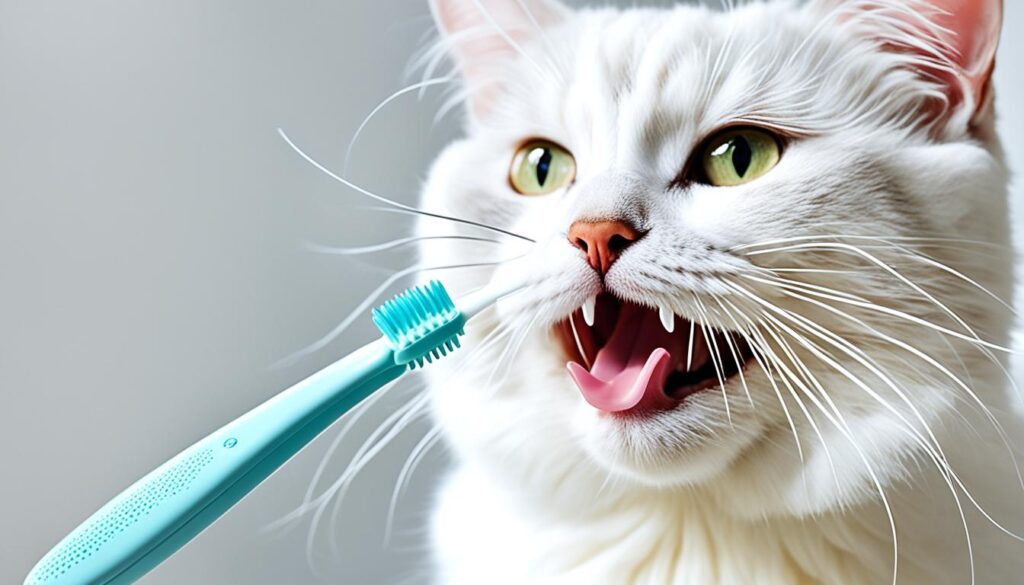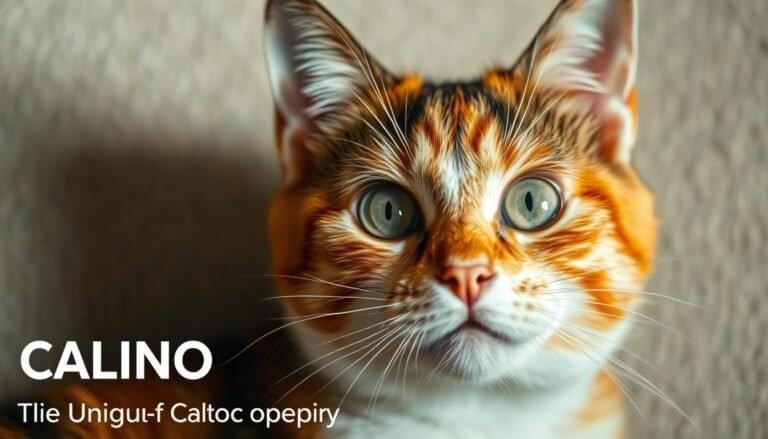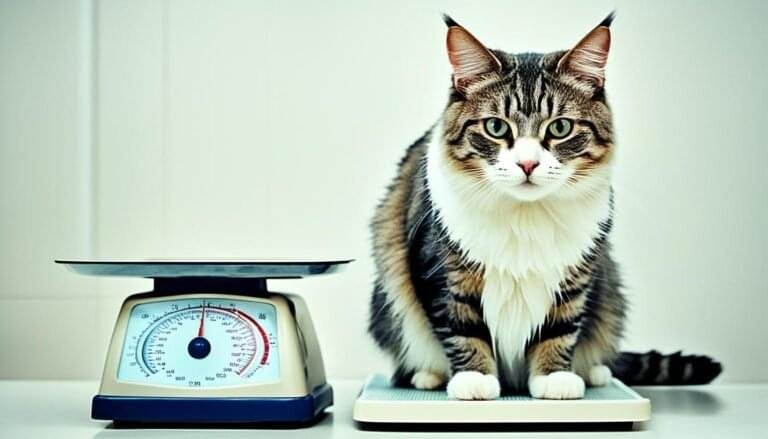How to Brush Cats Teeth?: Proper dental care is crucial for maintaining a cat’s overall health and well-being. Just like humans, cats are susceptible to dental issues such as plaque, tartar, and gum disease. However, many cat owners overlook the importance of brushing their cat’s teeth, leading to potentially serious oral health problems.
In this comprehensive guide, I will provide you with essential tips and techniques for brushing your cat’s teeth easily and effectively. From choosing the right toothbrush to training your cat to accept tooth brushing, I will walk you through the step-by-step process of maintaining optimal cat oral hygiene. Let’s dive in!
How to Brush Cats Teeth? Key Takeaways:
- Periodontal disease is common in cats, affecting up to 70% of them.
- Brushing a cat’s teeth is essential for maintaining their dental health and overall well-being.
- Regular brushing helps prevent plaque buildup and maintain good oral hygiene.
- Training cats to accept tooth brushing can be done at any age with patience and consistency.
- Choosing the right toothbrush and cat-specific toothpaste is crucial for successful brushing sessions.
Why should I brush my cat’s teeth?
Brushing a cat’s teeth is of utmost importance when it comes to their dental care. Just like humans, cats are prone to dental issues such as periodontal disease, which can have serious consequences if left untreated. Regular brushing helps prevent periodontal disease and maintains good oral hygiene for your feline companion.
Periodontal disease refers to inflammation and infection of the gums and supporting structures of the teeth. It starts with the buildup of plaque, a sticky film composed of bacteria, food particles, and saliva. If not removed, plaque can harden into tartar, which provides an ideal environment for bacteria to thrive. The effects of plaque and tartar can lead to gingivitis, an inflammation of the gums characterized by redness and swelling. If left untreated, gingivitis can progress to periodontal disease, causing pain, discomfort, and even tooth loss in cats.
Regular brushing helps remove plaque and prevent tartar accumulation. By diligently brushing your cat’s teeth, you can maintain their oral health and prevent dental diseases. It is the most effective way to keep their teeth clean and their gums in good condition. Just like with humans, prevention is key to avoiding more serious dental problems in cats.
The Effects of Plaque and Tartar on a Cat’s Teeth
Plaque and tartar can wreak havoc on a cat’s teeth and oral health. Here are some of the effects they can have:
- Gingivitis: The buildup of plaque and tartar can cause inflammation of the gums, resulting in gingivitis. This can lead to redness, swelling, and bleeding gums.
- Periodontal Disease: If left untreated, gingivitis can progress to periodontal disease. This causes the gums to recede and the supporting structures of the teeth to deteriorate, leading to tooth loss.
- Tooth Loss: The ultimate consequence of untreated periodontal disease is tooth loss. This can significantly impact a cat’s ability to eat and lead to further complications.
Considering the detrimental effects of plaque and tartar on a cat’s teeth, it is clear why brushing their teeth is vital for their overall well-being and quality of life.
| Dental Disease | Description |
|---|---|
| Gingivitis | Inflammation and swelling of the gums |
| Periodontal Disease | Infection and damage to the structures supporting the teeth |
| Tooth Loss | The permanent loss of teeth |
When should I brush my cat’s teeth?
Daily dental care is essential for cats to maintain their oral health and prevent dental issues such as plaque and tartar buildup. Starting the training process to accept tooth brushing while cats are still kittens is highly recommended, as they are more receptive to new experiences. However, adult cats can also be trained with patience and consistency.
The best time to brush your cat’s teeth is on a daily basis, as it allows for effective plaque removal and prevents tartar accumulation. Daily brushing sessions help minimize the risks of dental diseases and maintain optimal oral hygiene. However, if daily brushing seems challenging, a minimum of three times a week is recommended to remove plaque and mitigate dental problems.
Training your cat to accept tooth brushing may require some time and effort, but it’s worth it for their long-term health. With a gradual and gentle approach, you can help your cat get accustomed to tooth brushing and ensure their dental well-being. Remember to be patient, use positive reinforcement techniques, and make the experience as positive and comfortable as possible for your cat.
What steps should I follow to teach my cat to accept tooth brushing?
To successfully train a cat to accept tooth brushing, it is important to make the experience positive for both you and your cat. Follow these steps:
- Choose a quiet and comfortable location where you can safely handle your cat and prevent escape.
- Use positive reinforcement by creating a positive association with tooth brushing. Dip a cotton swab in tuna water and gently rub it along the gum line.
- Gradually introduce a toothbrush by allowing your cat to sniff and investigate it. You can also let them taste the toothpaste to get them familiar with the flavor.
- Lift your cat’s lips and gently brush the outer surfaces of their teeth using a circular motion. Start with a few teeth and gradually progress to brushing the entire mouth.
- Be patient and gentle, providing positive reinforcement such as treats and praise to reward your cat for cooperating during the training sessions.
Remember, consistency and positive reinforcement are key to successfully training your cat to accept tooth brushing.
Tips for Successful Cat Tooth Brushing:
- Start with short training sessions and gradually increase the duration.
- Choose a calm and quiet environment where your cat feels comfortable.
- Use a toothbrush specifically designed for cats, ensuring it has soft bristles to avoid discomfort.
- Make sure to use toothpaste formulated for cats, as human toothpaste can be harmful to them.
- If your cat resists tooth brushing, try different toothbrush options or consult with your veterinarian for additional tips and advice.
By following these steps and incorporating positive reinforcement, you can make tooth brushing a positive and manageable experience for your cat.
What type of toothbrush should I use?

When it comes to brushing your cat’s teeth, choosing the right toothbrush is crucial for effective oral hygiene. There are different types of toothbrushes specifically designed for cats, each with its own unique features and benefits. Let’s take a closer look at the various options available:
1. Angled Handle Toothbrushes
An angled handle toothbrush is a popular choice for cat owners due to its ergonomic design. The angled handle allows for better control and maneuverability, making it easier to reach the back teeth and clean hard-to-reach areas. This type of toothbrush is especially ideal for cats with smaller mouths or those who are more resistant to tooth brushing.
2. Finger Toothbrushes
Finger toothbrushes are another great option for brushing your cat’s teeth. These toothbrushes feature a soft rubber bristle pad that fits over your finger, providing a gentle and comfortable brushing experience for both you and your cat. Finger toothbrushes offer a more hands-on approach, allowing you to have better control and reach all areas of your cat’s mouth.
3. Small Handheld Toothbrushes
Small handheld toothbrushes are designed to be compact and easy to use. They typically have a smaller brush head and handle, making it convenient for you to hold and manipulate. This type of toothbrush is suitable for cats of all sizes and can effectively clean their teeth without causing discomfort.
4. Soft Bristles
When choosing a toothbrush for your cat, it is important to opt for one with soft bristles. Soft bristles are gentle on the gums and tooth enamel, minimizing the risk of irritation or injury. They also effectively remove plaque and tartar without causing discomfort, ensuring a pleasant brushing experience for your feline friend.
5. Bristle Size and Toothbrush Designs
The size of the bristles plays a significant role in proper cleaning. Choose a toothbrush with bristles that are small enough to reach below the gum line and effectively remove plaque and debris. Additionally, toothbrush designs may vary, ranging from traditional brush heads to specially designed bristle patterns that aid in plaque removal and gum stimulation.
Before selecting a toothbrush for your cat, it is always wise to consult with your veterinarian. They can provide personalized recommendations based on your cat’s specific needs, such as their dental health, age, and any existing dental issues.
Remember, regular tooth brushing using the right toothbrush is an essential part of your cat’s dental care routine. By investing in a quality toothbrush and practicing proper brushing techniques, you can help maintain your cat’s oral health and prevent dental problems in the future.
Is it okay to use human toothpaste?
When it comes to maintaining your cat’s dental health, using the right toothpaste is essential. While human toothpaste might seem like a convenient option, it can actually be harmful to your furry friend.
Human toothpaste contains ingredients that can be dangerous if swallowed by cats, such as fluoride and detergents. In addition, many human toothpastes contain artificial sweeteners like xylitol, which is toxic to pets. These ingredients can cause digestive distress and even poisoning in cats.
In order to properly care for your cat’s teeth and gums, it is important to use toothpaste specifically formulated for pets. Pet toothpaste is designed to be safe for cats and comes in flavors that are appealing to them. It does not contain any harmful ingredients that could potentially harm your feline friend.
Using pet toothpaste ensures that your cat receives the dental care they need without putting their health at risk. By using the right toothpaste, you can effectively remove plaque and tartar, prevent dental diseases, and maintain your cat’s oral hygiene.
| Human Toothpaste | Pet Toothpaste |
|---|---|
| Contains harmful ingredients such as fluoride and detergents | Formulated specifically for pets, without harmful ingredients |
| Can cause digestive distress and poisoning in cats | Safe for cats when swallowed in small amounts |
| Usually has flavors that are not appealing to cats | Comes in flavors that cats find appealing |
Using human toothpaste on cats may seem like a quick fix, but it can have serious consequences for their health. By choosing the right toothpaste specifically made for cats, you can ensure their safety and maintain their oral health. So, when it comes to caring for your cat’s teeth, always opt for pet toothpaste.
What You’ll Need to Brush Your Cat’s Teeth

To effectively brush your cat’s teeth, you will need the following supplies:
Cat Toothbrush
There are different options available for cat toothbrushes. Choose a toothbrush specifically designed for cats to ensure optimal cleaning. Some options include:
- Small brushes designed for cats
- Finger toothbrushes
- Soft bristle toothbrushes designed for human babies
Cat Toothpaste
Cat toothpaste is specially formulated for cats and comes in flavors that cats find appealing. It contains enzymes that help break down food particles and bacteria, promoting oral hygiene. Avoid using human toothpaste, as it may contain ingredients that are harmful to cats if swallowed.
Treats or Toys for Positive Reinforcement
Positive reinforcement is crucial in training your cat to accept tooth brushing. Use treats or toys that your cat enjoys to reward them for cooperating during the brushing sessions. This will create a positive association with tooth brushing and make the experience more enjoyable for your cat.
By having these cat tooth brushing supplies ready, you can ensure a successful and effective tooth brushing routine for your feline friend.
How to Brush Cats’ Teeth: Step-by-Step Instructions
When it comes to brushing a cat’s teeth, a step-by-step approach is essential for success. By following these instructions, you can ensure that your cat receives effective tooth brushing while maintaining their comfort and cooperation.
Step 1: Prepare and Introduce
Before starting the tooth brushing session, gather the necessary supplies: a cat toothbrush and cat toothpaste. Introduce these items to your cat to familiarize them with the process.
Step 2: Find a Comfortable Position
Place your cat on your lap or in a secure and comfortable position that allows you to access their mouth easily. This will help create a calm and relaxed environment for both you and your cat.
Step 3: Lift the Lips
Gently lift your cat’s lips to expose their teeth and gums. This step may require practice and patience, especially if your cat is not accustomed to having their mouth handled.
Step 4: Introduce Toothpaste
Squeeze a small amount of cat toothpaste onto the toothbrush. Allow your cat to sniff and taste the toothpaste, as most cat toothpaste has flavors that appeal to them.
Step 5: Begin Brushing
Start by brushing a few teeth at a time using a circular motion on the outer surfaces of the teeth. Focus on the gum line where plaque tends to accumulate. Gradually increase the number of teeth brushed with each session.
Step 6: Be Gentle and Patient
Throughout the tooth brushing session, maintain a gentle touch and be patient with your cat. It may take time for them to adjust to the sensation and routine of tooth brushing.
Step 7: Use Positive Reinforcement
After each successful tooth brushing session, reward your cat with treats, praise, or playtime. This positive reinforcement will help to create a positive association with tooth brushing.
Step 8: Gradually Increase Duration
Initially, keep tooth brushing sessions short, around 30 seconds per side. As your cat becomes more comfortable and accustomed to the routine, gradually increase the duration of each session.
Step 9: Establish a Regular Routine
To maintain good oral hygiene, establish a regular tooth brushing schedule. Aim to brush your cat’s teeth at least three times a week to remove plaque and prevent tartar buildup.
Step 10: Monitor and Adapt
Observe your cat’s oral health and monitor for any signs of dental issues. If you notice any problems or resistance during tooth brushing, consult with your veterinarian for guidance and support.
By following these step-by-step instructions, you can effectively brush your cat’s teeth and contribute to their overall dental health and well-being.
How Often Should You Brush Your Cat’s Teeth?
Daily brushing is the gold standard for maintaining optimal oral hygiene in cats. Plaque, which is a sticky film that forms on the teeth, can harden into tartar within 48 to 72 hours if not removed. Regular brushing helps prevent tartar buildup and reduces the risk of dental disease in cats. While daily brushing is ideal, a minimum of three times a week is recommended to effectively remove plaque and maintain your cat’s dental health.
Consistency is key when it comes to cat tooth brushing. Even brushing your cat’s teeth once or twice a week can still have significant benefits. The more frequently you brush, the better chance you have of preventing tartar accumulation and promoting good oral health.
The Recommended Brushing Schedule for Cats
To provide a guideline for maintaining proper cat dental care, here is a recommended brushing schedule:
| Frequency | Benefits |
|---|---|
| Once a day | – Maximum plaque removal – Optimal prevention of tartar buildup – Best overall dental care |
| Every other day | – Good plaque control – Effective tartar prevention – Significant improvement in dental health |
| Three times a week | – Adequate plaque removal – Moderate tartar prevention – Maintenance of acceptable dental health |
Remember, the frequency of brushing directly impacts your cat’s dental health. The more often you brush, the better chance you have of preventing oral issues such as gum disease and tooth decay.
How to Keep Cats’ Teeth Clean Without Brushing
While brushing is the most effective way to clean a cat’s teeth, there are alternatives available for maintaining oral hygiene. Dental treats and water additives can help remove and prevent plaque, but they should be used in addition to regular tooth brushing for optimal results. These products can be used as a supplement to brushing or as a temporary solution for cats who are resistant to tooth brushing. However, they are not as effective on their own and should not replace regular brushing sessions.
Alternatives to Brushing Cat’s Teeth
If your cat refuses to tolerate tooth brushing, there are alternative cat dental care products that can help improve oral hygiene:
- Dental treats for cats: Dental treats are specifically designed to promote oral health. They contain ingredients that help reduce plaque and tartar buildup while freshening your cat’s breath. Look for treats approved by veterinary dental associations and choose ones that have a texture that helps mechanically clean the teeth.
- Water additives for oral hygiene: Water additives are liquid solutions that can be added to your cat’s drinking water. They work by reducing plaque and tartar formation and maintaining fresher breath. Make sure to follow the instructions on the product label for proper dosage.
Cat Dental Care Products Comparison
To help you choose the most suitable cat dental care product, here is a comparison table:
| Product | Benefits | Usage | Price Range |
|---|---|---|---|
| Dental Treats | – Reduces plaque and tartar buildup – Freshens breath – Provides a tasty treat |
– Offer treats as recommended by the manufacturer – Monitor your cat while consuming treats – Use in addition to regular tooth brushing |
$10 – $20 (pack of treats) |
| Water Additives | – Reduces plaque and tartar formation – Freshens breath – Convenient to use |
– Add the recommended amount to your cat’s drinking water – Change the water daily, including the additive – Use in addition to regular tooth brushing |
$5 – $15 (bottle of additive) |
Remember, although these alternative products can contribute to your cat’s oral hygiene, they should not replace regular tooth brushing. Brushing is still the most effective way to remove plaque and prevent dental problems. Consult with your veterinarian for specific recommendations based on your cat’s individual needs.
Tips and Troubleshooting for Brushing Your Cat’s Teeth
To ensure successful tooth brushing sessions for your cat, it is important to approach the process with patience and positive reinforcement. Here are some tips to make cat tooth brushing a positive experience:
- Start with short training sessions: Begin by introducing your cat to tooth brushing gradually. Start with short sessions to get them used to the process before gradually increasing the time.
- Choose a calm and quiet environment: Find a quiet area where your cat feels comfortable and relaxed. This will help reduce distractions and make the experience more enjoyable for both of you.
- Use a toothbrush designed for cats: Select a toothbrush that is specifically designed for cats. These toothbrushes have soft bristles and are the perfect size for their mouth.
- Make tooth brushing a positive experience: Reward your cat with treats or praise after each successful tooth brushing session. This positive reinforcement will create a positive association with tooth brushing.
- Consult with your veterinarian: If your cat is resistant to tooth brushing or you are facing any difficulties, consult with your veterinarian. They can provide additional tips and advice tailored to your cat’s needs.
Overcoming resistance to tooth brushing may take time and patience, but with the right techniques and a positive approach, you can successfully brush your cat’s teeth and maintain their oral health.
Troubleshooting Common Issues
If you encounter any of the following issues while brushing your cat’s teeth, here are some troubleshooting tips:
- Gagging or retching: If your cat is experiencing gagging or retching during tooth brushing, try using a smaller brush or a finger toothbrush to minimize discomfort.
- Excessive drooling: Some cats may drool more than usual during tooth brushing. This is normal and should subside over time as they become more accustomed to the process.
- Resistance or aggression: If your cat becomes resistant or aggressive during tooth brushing, take a step back and try again later. Approach the process calmly and offer rewards to encourage cooperation.
- Bleeding or inflamed gums: If you notice bleeding or inflamed gums, this could be a sign of dental issues. Consult with your veterinarian to determine the underlying cause and address any necessary treatments.
By troubleshooting these common issues and adapting your approach, you can overcome challenges and continue providing proper dental care for your cat.
| Troubleshooting Issue | Troubleshooting Tip |
|---|---|
| Gagging or retching | Try using a smaller brush or finger toothbrush |
| Excessive drooling | Give your cat time to adjust and be patient |
| Resistance or aggression | Take a step back, approach calmly, and offer rewards |
| Bleeding or inflamed gums | Consult with your veterinarian for further evaluation and treatment |
Conclusion
Regular tooth brushing is crucial for maintaining the dental health of your cat. Periodontal disease is a common issue in cats, but with proper dental care, including regular brushing, it can be prevented. Although training cats to accept tooth brushing may require patience and consistency, the benefits far outweigh the effort.
By following the recommended techniques, using the right toothbrush and toothpaste, and maintaining a regular brushing schedule, you can ensure your cat’s oral hygiene and prevent dental diseases. Plaque and tartar buildup can lead to gingivitis and ultimately result in tooth loss, causing pain and discomfort for your feline friend. Taking care of your cat’s teeth is an essential part of their overall well-being.
Make tooth brushing a positive experience for your cat by using treats and praise as positive reinforcement. Choose a quiet and comfortable location for the brushing sessions, and gradually introduce the toothbrush, starting with a few teeth and progressing to the entire mouth. Remember to be gentle and patient to ensure your cat’s cooperation.
By prioritizing your cat’s dental care, you are ensuring their long-term health and happiness. Regular brushing, along with other dental care products and techniques, can help maintain good oral hygiene in your cat. Invest the time and effort into brushing your cat’s teeth, and they will thank you with a healthy and beautiful smile.
FAQ
Why should I brush my cat’s teeth?
When should I brush my cat’s teeth?
What steps should I follow to teach my cat to accept tooth brushing?
What type of toothbrush should I use?
Is it okay to use human toothpaste?
What You’ll Need to Brush Your Cat’s Teeth?
How to Brush Cats’ Teeth: Step-by-Step Instructions?
How Often Should You Brush Your Cat’s Teeth?
How to Keep Cats’ Teeth Clean Without Brushing?
Tips and Troubleshooting for Brushing Your Cat’s Teeth?
Conclusion
References
| International Cat Association (TICA) | https://www.tica.org/ |
| The Cat Fanciers’ Association (CFA) | https://cfa.org/ |
| World Cat Federation (WCF) | https://www.wcf-online.de/ |
| Fédération Internationale Féline (FIFe) | https://www.fifeweb.org/ |







